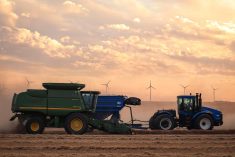CNS Canada — The way things stand now, soybeans look to continue their strong push into Manitoba and Saskatchewan.
The key pod-filling time in late July and early August will ultimately decide, but soybean fields in both provinces are doing well so far.
In Manitoba, which planted almost 2.23 million acres of soybeans — a record for the province — recent warm weather and drying winds have boosted plants out of earlier problems.
Dennis Lange, pulse specialist with Manitoba Agriculture in Altona, said most soybeans have grown out of iron deficiency chlorosis problems, which were due mainly to the wet soils from last year and the higher salt levels that caused in some fields.
Read Also

India slaps 30 per cent import duty on yellow peas
India has imposed a 30 per cent duty on yellow pea imports with a bill of lading date on or after Nov. 1, 2025.
But he’s not making any predictions just yet. Estimates about the size of the future crop will become clearer in August.
Currently, plants are in the R2 to R3 stage of development, which means they are near the end of flowering with some plants starting to pod. Overall, he said, soybean fields are looking very good so far.
“If we get the moisture when pods are filling, that means good things for yield.”
Last year’s record-breaking yields of 42 bu./ac. can be credited to the near perfect timing of rain that fell in late July and early August, he said.
The average yield for Manitoba is 35 bu./ac.
With about 2.23 million acres seeded, given average yields, Manitoba soybean growers should harvest about 78.05 million bushels. If the rains come and lift soybeans to match last year’s record yield, then growers could produce as much as 93.66 million bushels.
“Basically, we’re at the tail-end of flowering, so yeah, everything looks green. Some fields look shorter than others, but you know what? You don’t need a tall plant to get yield. You just need lots of pods,” Lange said.
Manitoba growers seeded 1.65 million acres of soybeans in 2016.
Shannon Friesen, cropping management specialist with Saskatchewan Agriculture in Moose Jaw, said most soybeans in that province were doing well, depending on location.
With a record 850,000 acres seeded this year, Friesen said crops were behind normal but that appears likely to change.
“We had quite cool conditions to begin with so things took a bit more time to develop and take off,” she said.
Plants are just now hitting the flowering stage, she said, with podding still a ways away. She expected the recent heat would help them advance. Rain would also be critical during late July and into August, she added.
Some soybean fields appear short, she said, which applies to many crops in the arid southern part of the province.
“Only time will tell, as with all of our crops. They (soybeans) look better than some of our other ones, that’s for sure,” she said.
While some rain fell in the parched south, Friesen said it was not enough. She said any rain now will come too late for some crops, but some others, such as soybeans, could still benefit.
She said the ministry would have more information about potential yields in August, once pods have filled.
Meanwhile, grain corn is tasseling in the key growing areas of central and eastern regions of Manitoba.
Anne Kirk, a Manitoba Agriculture cereal crop specialist in Carman, said corn fields are mostly in the V7 to V12 stage. Manitoba growers seeded 400,035 acres of corn this year. That compares to 329,411 acres a year ago.
— Terry Fries writes for Commodity News Service Canada, a Winnipeg company specializing in grain and commodity market reporting. Follow CNS Canada at @CNSCanada on Twitter.












